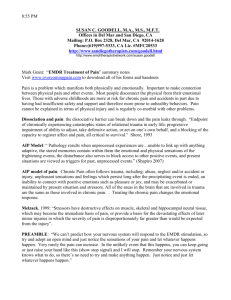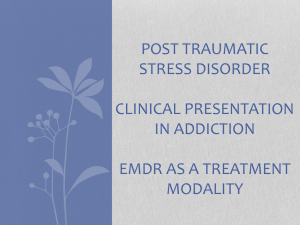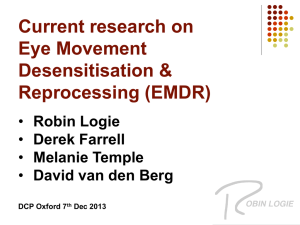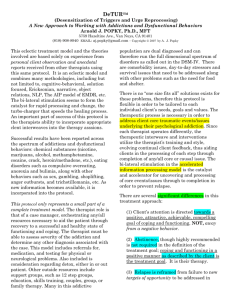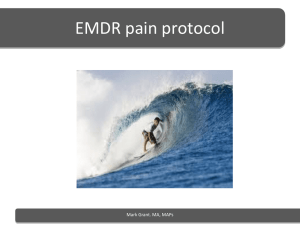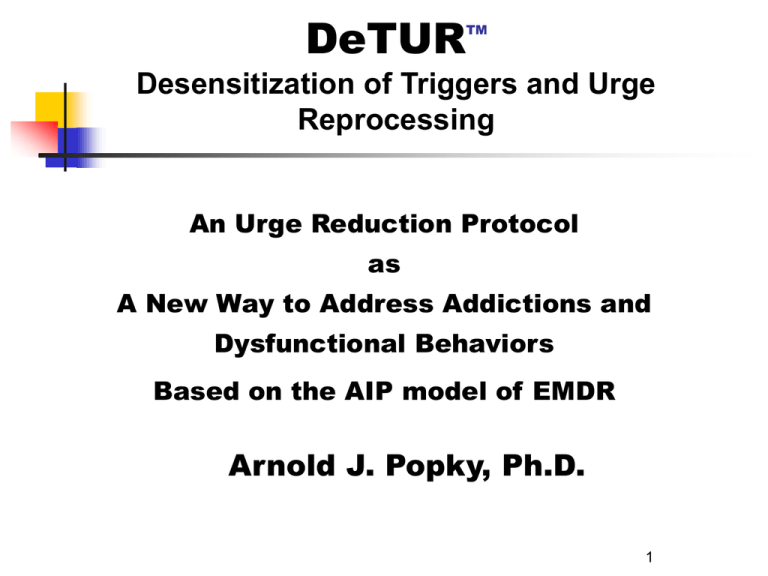
DeTUR
TM
Desensitization of Triggers and Urge
Reprocessing
An Urge Reduction Protocol
as
A New Way to Address Addictions and
Dysfunctional Behaviors
Based on the AIP model of EMDR
Arnold J. Popky, Ph.D.
1
Addiction Treatment Model
RELAPSE
MANAGEMENT
HISTORY
ASSESSMENT
DIAGNOSIS
DUAL ??
COMORBIDITY
ISSUES
TRAINING
JOB SKILLS
DeTUR
SOCIAL
PROTOCOL
REFERRALS
MD
MEDICATIONS
OUTPATIENTIN
PATIENT
(DETOX)
CRISIS
MANAGEMENT
DRUG EDUCATION
HOUSING, FOOD
THERAPY
GROUP/FAMILY
SUPPORT
AA, MM, RR
RELIGOUS, ETC
2
Basis of Addictions
DISEASE
Genetic
Chemical
Modeling
?
TRAUMA
3
ADAPTIVE INFORMATION
PROCESSING MODEL
Internal Survival Mechanism
CUT
Dysfunctional
[not useful]
Daily Events
CONTINUUM
CONTINUUM
REM
HEAL
Functional
[useful]
COPE
TIME
EXPERIENCE
SUPPORT
4
Trauma
[Insufficient Resources]
smells
taste
feelings
internal representations
TRAUMA
T&ts
sounds
pictures
ANXIETY
body sensations
5
Relieving Anxiety
tsmells
ttaste
tinternal representations
TRAUMA
tfeelings
tsounds
tpictures
tbody sensations
ANXIETY
SOLUTION
CIGARETTES
ALCOHOL
DRUGS
FOOD
SEX
ANGER
ETC.
ANXIETY
6
Conditioned Response
POSITIVE REINFORCEMENT AND REPETITION
t
internal
representations
t
smells
t
t
sounds
TRAUMA
ANXIETY
t
pictures
taste
t
t body sensations
feelings
SOLUTION
CIGARETTES
ALCOHOL
DRUGS
FOOD
SEX
ANGER
ETC.
ANXIETY
7
Solution = Problem
tsmells
tinternal representations
tsounds
ttaste
TRAUMA
tfeelings
tpictures
tbody sensations
ANXIETY
SOLUTION
CIGARETTES
ALCOHOL
DRUGS
FOOD
SEX
ANGER
ETC.
ANXIETY
8
Polysubstance Abuse
t
internal
representations
t
smells
t
t
sounds
TRAUMA
feelings
SOLUTION
CIGARETTES
t pictures
NEW SOLUTION
taste
t
ANXIETY
t body sensations
ALCOHOL
DRUGS
FOOD
SEX
ANGER
ETC.
ANXIETY
9
Trauma Reprocessed
t
internal
representations
t
smells
t
t
sounds
TRAUMA
t pictures
taste
t body sensations
t
feelings
ANXIETY
SOLUTION
CIGARETTES
ALCOHOL
DRUGS
FOOD
SEX
ANGER
ETC.
10
Addictive Population
?
Gender
Age
Race
Religion
Culture
Education
Economic status
Sexual preference
11
Commonality
DUAL+ DIAGNOSIS!!!!
12
DeTUR
Developed through clinical experience (personal and others)
Written on Rubber
Flexible to match client’s world
Only ONE component of addiction treatment
Requires client desire and commitment
In depth use of therapeutic interweave
Utilizes therapist’s training and experience
13
EMDR or DeTUR
where to start
EMD
EMDR
R
DeTUR
DeTUR
Trauma known
Behavior
EMDR [trauma]
and/or
DeTUR [relapse]
14
Differences in Approach
Treatment goals are defined by the client
Therapeutic interventions accommodate clinician’s style and training
Individualize therapy to address core issues behind behavior
Targets triggers that bring up the urge to use [tn]
Builds coping skills
Deals with withdrawal symptoms
Addresses relapse
Ego strength enhancement
15
Why Target Triggers vs
Trauma?
TRAUMA
EGO STRENGTH
t
1
t2
TRIGGERS
tn
16
RAPPORT
HISTORY
EMPOWERMENT
RESOURCE
STATE
ASSESSMENT
PREPARATION
WHAT DO YOU
WANT WHAT
WILL IT
GET YOU
HOW WILL
YOU KNOW
WHAT
PREVENTS
YOU
WHAT
DO YOU
NEED
POSITIVE
GOAL
POSITIVE
STATE
IDENTIFY
TRIGGERS
DESENSITIZE
TRIGGERS
FUTURE
TEMPLATE
CLOSURE
RELAPSE
PREVENTION
INSTALL
POSITIVE
FOLLOW
ON
17
EMDR Flow Chart
PAST [TE]
PRESENT[TRIGGERS]
PHASE 2
PHASE 1
HISTORY
Presenting problem
NC
PC
Float back/affect
bridge
PREPARATION
PHASE 3
PHASE 4
ASSESSMENT
DESENSITIZATION
Explanation
*Target[TE]
Pic+nc+body
Mechanics
NC
BLS
Safe place
PC
SUDS=0
Resource
VOC
SUD
*Touchstone event[TE]
Body location
PHASE 5
INSTALLATION
FUTURE [TEMPLATE]
PHASE 6
PHASE 7
PHASE 8
BODY SCAN
CLOSURE
FUTURE TEMPLATE
VOC=7
*Target+pc
learned/insights?
*Target+pc
Pos or Neg
BLS
BLS
BLS
Incomplete?
Relaxation
How would you
prefer
Run movie
Notice snag/neg
BLS
Run till clear
18
Safe Therapeutic Environment
“Rapport”
The foundation for trust in any relationship is rapport. It is the high
level of trust the client feels with the therapist causing the safe
therapeutic relationship. One of the most important characteristics
of a therapist is the ability to gain trust rapidly, and to maintain it
throughout the therapeutic process. Rapport gives the therapist the
right to ask questions and to elicit appropriate answers. This is
crucial for this for success in this model.
19
History/Assessment
Genogram
Thinking/decision making process
Coping styles skills
Source of interweaves
Affect management
Addiction history
Safety issues
Resources: internal/external
Previous therapy
Medications
20
Assessment
Medications?
Where to start?
AIP/EMDR - Trauma
AIP/DeTUR -Triggers
EMDR treats the client NOT the diagnosis
21
Diagnosis
Abandonment Issues
Dissociative? How much/when
DID
EMDR treats the client NOT the diagnosis
22
Where to start….
TRAUMA
IDENTIFIED
PRESENTING
PROBLEM
EMDR
PROTOCOL
TRAUMA UNCOVERED
TRIGGERS
DeTUR
IDENTIFIED
PROTOCOL
23
Preparation
Commitment from the client and the desire to heal
Check for client safety and stability
Explanation of bi-lateral stimulation and the process
Train metaphor
Change: pictures, memories, body sensations
[ Minnie mouse in Malibu]
Emotions
[hill metaphor]
Stop signal
12 step suggestions
24
Accessing Internal Resources
Recall previous time when feeling empowered
Access fully - feed back to client
Bi-lateral stimulation to enhance (rapid =>24)
Word for auditory anchor
Check with client (non-verbals for congruence)
Test
time freeze
model someone known
fictional character
25
Positive Treatment Goal (PG)
What do they want……..What will it get them?
Theory [VISUALIZATION]
Elicited from client
Coping & Functioning
Abstinence not necessary
Positive terms
Component specifics
Within time constraints
Picture
Adjustments to enhance
BLS
Test
26
Positive State (PS)
How will you know?
•
•
•
•
•
•
Theory
Associate with/step into [as if]
Anchoring the feelings
Build
Test
Enhance anchor w/BLS
=
27
Identifying Triggers
How do they know when to……
Person
Place
Thing
Time
Emotion
Situational
Action
Smell
Taste
28
Prioritize
The worst addiction first
Coke>Alcohol>Cigarettes
The least powerful urge (t) first
If smoking: start at the first of the day
29
Desensitize Triggers
YES
CHANGE
“GO WITH
THAT”
YES
TRIGGER
#1
PICTURE
ASSOCIATED
SMELLS
TASTES
FEELINGS
SOUNDS
LOU
0 to 10
“WHERE ARE
YOU FEELING
IT?”
HOLD PICTURE &
BODY SENSATION
TOGETHER
“WHAT ARE YOU
BLS GETTING NOW?”
CHANGE?
LOU = Level of Urge
BLS = Bi Lateral Stimulation
30
Desensitize Triggers
NO CHANGE
TRIGGER
#1
PICTURE
LOU
0 to 10
“WHERE ARE
YOU FEELING
IT?”
HOLD PICTURE &
BODY SENSATION
TOGETHER
BLS
“WHAT ARE YOU
GETTING
NOW?”
CHANGE
DIRECTION
SPEED
NUMBER
WIDTH
TAP
SOUNDS
31
CHANGE?
NO
What Can Happen!
If
If
If
If
If
If
If
If
client abreacts
client dissociates
client intellectualizes
interruptions or therapist gets lost
response changes to positive
therapist notices change in physiology; Milton yes
client looping
thread opens to trauma
32
Installation
TRIGGER
#1
ASSOCIATED
PICTURE
SMELLS
TASTES
FEELINGS
SOUNDS
BLS
“WHAT ARE YOU
GETTING NOW?”
POSITIVE
RESPONSE
?
YES
“GO WITH
THAT”
NO
CHECK LOU
AND
DESENSITIZE
33
Future Template
“GO WITH
THAT”
IMAGINE A
TIME IN
THE
FUTURE
TRIGGER
#1
PICTURE
LOU
0 to 10
“WHERE ARE YOU HOLD PICTURE &
FEELING IT?”
BODY SENSATION
TOGETHER
“WHAT ARE YOU
BLS GETTING NOW?”
ASSOCIATED
SMELLS
TASTES
FEELINGS
SOUNDS
Install future positive state of success
Theory: Skills building to handle future triggers
34
YES
CHANGE?
Closure & Relapse
Reframing relapse (artichoke)
Continuing process
Use of support structures
Homework: Use of anchors
Emotional Freedom Techniques (EFT)
35
Follow on Sessions
Enhance any/all successes w/BLS
Target new emerging triggers (relapse)
Work through remaining triggers
36
Research
Sexual Compulsivity
The use of the DeTUR method utilized as the primary
treatment modality with 24 clients who identified
sexual compulsivity as their principal treatment issue.
DeTUR was utilized to access an internal resource
state, install their positive goal state. and anchor it in
their physiology), to desensitize known triggers to
decrease the risk of relapse behavior, and access
these positive resources in the future.
37
Research
Sexual Compulsivity
The subjects were selected from a client base of over 60
clients who self-reported sexual compulsivity and also
met the clinical criterion for a diagnosis of sexual
compulsivity using Dr. Patrick Carnes’ Sexual
Assessment Screening Test (SAST).
38
Research
Sexual Compulsivity
Group A-talk therapy only, reported a richer understanding of their
sexually compulsive behaviors and also reported struggling with
relapse issues due to no symptom relief.
Group B-EMDR treatment, reported a significant decrease in their
SUDS, VoC, trauma profile, and an increase in their healthful living
scale. They also reported struggling with relapse issues.
Group C-DeTUR treatment, reported a significant decrease in their
LOU level, but did not report a significant decrease in their trauma
profile or an increase in their healthful living scale.
Group D-EMDR and DeTUR treatment reported a significant decrease
in their SUDS, VoC, LOU, trauma profile, and an increase in their
healthful living scale.
39
RESEARCH
Sexual Compulsivity
RESEARCH DESIGN
CONTROL
GROUP
# OF SUBJECTS
# OF SESSIONS
TREATMENT
MODALITY
GROUP A
6
10
TALK THERAPY
GROUP B
6
10
EMDR
GROUP C
6
10
DeTUR
GROUP D
6
10
EMDR + DeTUR
40
Research
Sexual Compulsivity
Preliminary findings appear to indicate that the use of EMDR
and DeTUR are effective means in treating sexually compulsive
behaviors.
Further research studies are needed to examine the use and
effectiveness of EMDR, DeTUR and traditional talk therapy in
the treatment of sexual compulsivity and other addictions.
41
RESEARCH
Domestic Violence
Dr. R. Bata
Conflict Tactic Scale 2 (CTS2) was administrated as pre and post test
measurement scale.
Concentration was on Psychological Aggression & Physical Assault
5 Individual sessions
Pre test was validated by police reports & history of abuse in
relationships
Post test was validated by CJIC database by Domestic Violence Unit of
the Distric Attorney’s Office at 1 & 2 years
42
RESEARCH
Domestic Violence
Dr. R. Bata
PSYCHOLOGICAL AGGRESSION
SUBJECT
FREQUENCY
PRE TEST
POST TEST
1
2
3
2
1
4
3
5
0
4
8
0
5
6
3
SUM=22
SUM=10
43
RESEARCH
Domestic Violence
Dr. R. Bata
PHYSICAL ASSULT
SUBJECT
FREQUENCY
PRE TEST
POST TEST
1
0
0
2
0
0
3
0
0
4
2
0
5
1
1
SUM=3
SUM=1
44
RESEARCH
Domestic Violence
Dr. R. Bata
After 2 years
A decrease of 45% in the number of emotionally
abusive incidents
A decrease of 65% in the number of physically
abusive incidents
45

